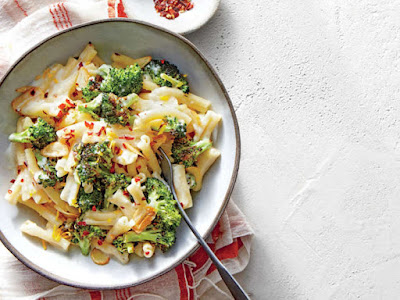I love Pancakes.....I love Pancakes period....So when I saw this recipe...I had to include it in this blog!
In a taste test of seltzer pancakes versus plain water pancakes, the seltzer pancakes were noticeably more fluffy! Just like using seltzer water in tempura batter makes a light and airy batter, when you add seltzer into pancake mix, tiny bubbles of air are infused into the batter, and expand when heated. (Pro tip: Make sure to keep the water cold, as there are more bubbles in cold seltzer than room temperature.)
With this knowledge, putting together a diner-style pancake recipe wasn't hard. I started with my favorite thin pancake recipe, food director Rhoda Boone's buttermilk pancakes, and I swapped in some seltzer water for a portion of the buttermilk, then added a little more flour to give Rhoda's thin and crispy pancakes a little extra body to showcase those bubbles and rise in height as they cook.
3. Use a Griddle to Cook Your Pancakes
At every diner, pancakes are cooked on a super-hot griddle, giving them a nicely browned crust and a quick rise in height. You can't install a diner-style griddle in your home kitchen, but a two-burner griddle allows you to turn your stovetop into a diner-style cooking surface, and cook more pancakes faster than you could in a single skillet. If you don't have a griddle, a cast-iron skillet is your next best choice for the best pancakes crust.
4. Pour Them Out by the 1/2 cup
For true diner-style seltzer pancakes, you want them to be as big as your plate, which means you have to pour out 1/2 cup of batter onto your griddle for each pancake. If you want smaller pancakes (which are easier to flip) you can use a 1/4 cup measure instead to pour them out. At The Greeks, Koutsouris makes dozens of pancakes in the course of a busy Saturday, but for a group of four friends (or family), eight pancakes should do it, so I've designed my recipe to make eight plate-size pancakes.
5. Think Beyond Maple Syrup
Before you douse these cloud-like confections in maple syrup, you might want to try doingsomething different..Replacing Maple Syrup with Grape or Strawberry Preserves or Jelly.There's only one way to make fluffy pancakes, but there are lots of ways to top them.
Here is the actual recipe for Diner Style Buttermilk Pancakes-
INGREDIENTS:
- 2 cups all-purpose flour
- 3 tablespoons sugar
- 1 1/4 teaspoons baking powder
- 1 1/4 teaspoons baking soda
- 1 1/4 teaspoons kosher salt
- 2 large eggs
- 1 3/4 cups buttermilk
- 1/2 cup cold seltzer water or club soda
- 1 teaspoon vanilla extract
- 3 tablespoons unsalted butter, melted, plus more
- Pure maple syrup (for serving, but optional...See Above..)
DIRECTIONS:
- Whisk flour, sugar, baking powder, baking soda, and salt in a large bowl. Using a fork, beat eggs, buttermilk, seltzer, vanilla, and 3 Tbsp. melted butter in a medium bowl to incorporate eggs. Add egg mixture to dry ingredients and whisk to combine (batter will be slightly lumpy).
- Heat a large griddle or 2 cast-iron or nonstick skillets over medium; brush with butter. Working in batches, scoop 1/2-cupfuls of batter onto griddle; cook until bubbles form on the surface and pop and the underside is golden brown, 2 1/2–3 minutes. Flip and continue to cook until golden brown on the bottom, 2–2 1/2 minutes more. Transfer pancakes to plates or a platter and brush tops with butter. Serve with maple syrup alongside.
Don't Sweat The Technique-
To feed a larger group, double the recipe and keep pancakes warm in a 250°F oven between batches. If you don't have a griddle or 2 skillets, use 1 skillet to cook the pancakes.
ENJOY! EAT WELL MY FRIENDS!















































